Quantitative Evaluation of Runoff Simulation and Its Driving Forces Based on Hydrological Model and Multisource Precipitation Fusion
Abstract
:1. Introduction
2. Materials and Methods
2.1. Study Area
2.2. Materials
2.3. Methods
2.3.1. Optimized Bayesian Mean Algorithm (OBMA)
- (1)
- Initialization (our research set iter = 0), given the initial weights and variances of each precipitation product:where NT is the length of the time sequence; ot and are the observations at t time and the simulations of the nth precipitation product, respectively.
- (2)
- Calculate the likelihood values of the initial parameters:
- (3)
- Let Iter = Iter + 1 and calculate the iterative value of the hidden variable:
- (4)
- Calculation of weights for each precipitation product based on :
- (5)
- Recalculate the deviation of each precipitation product:
- (6)
- Calculate the likelihood values of the parameters at the nth iteration state:
- (7)
- Convergence check: if the lIter(θ) − lIter−1(θ) is less than the preset threshold (set to 0.0001 in this study) or the number of iterations exceeds the preset upper limit (10,000 iterations in this study), the iteration stops. Otherwise, return to step (3).
- (8)
- The optimal weights of each precipitation product can be obtained by steps (1) to (7). Based on the optimal weights, our research combined and integrated six SPPs to obtain 57 daily BIPPs.
- (9)
- The distance between simulations and observations (DISO) of 57 daily BIPP is evaluated by calibration stations, and the minimum DISO is selected to obtain a new daily precipitation product. Our research overcomes the limitation that traditional BMA is affected by SPPs. The DISO calculation formula is as follows [36]:where BIAS is used to express the bias between simulations and observations; CC is to describe the degree of agreement between simulations and observations; RMSE or NRMSE is used to show the magnitude of the error between simulations and observations; DISO is used to describe the overall characteristics of simulations relative to observations; n represents the length of the time sequence; Gi (Si) represents the ith observations (simulations); represents the average of observations (simulations); NRMSE is RMSE divided by .
2.3.2. VIC Model
2.3.3. Statistical Method
2.3.4. Budyko Framework
3. Results
3.1. OBMA Parameter Estimation
3.2. Evaluation of Multisource Integrated Precipitation Products
3.2.1. Daily Precipitation Accuracy Evaluation
3.2.2. Precipitation Events Accuracy Evaluation
3.2.3. Monthly Scale Accuracy Evaluation
3.3. Hydrological Assessment of Multisource Integrated Precipitation Products
3.3.1. Simulation of Daily Runoff and Evapotranspiration
3.3.2. Uncertainty Analysis
4. Discussion
5. Conclusions
- (1)
- OBIPP (GEPC+) is remarkably correlated with ground-based observations and displays the lowest RMSE and highest CC at the daily scales. OBIPP across the SRYR exhibited excellent performance at the monthly scales, while BIPP (GETPCC+) across the other regions revealed good performance.
- (2)
- OBIPP and BIPP exhibited the highest POD values for the detection accuracy of precipitation events. ERA and CPC exhibit the lowest and highest FAR values, respectively. OBIPP exhibited the highest ETS, followed by GETPCC+ and ERA.
- (3)
- The VIC model driven by daily OBIPP with a Nash coefficient (NSE) of runoff simulation for both calibration and validation periods exceeds 0.74 and 0.81, respectively. The simulated runoff and evapotranspiration of the VIC model driven by daily OBIPP exhibit the highest CC and NSE during the validation periods. Overall, the daily precipitation corrected by the OBMA can meet the application requirements of hydrological simulation.
- (4)
- OBIPP simulation results show that the average annual precipitation and runoff depth across the SRYR was 621 mm and 63.50 mm from 2001 to 2019, respectively, showing the spatial pattern of increasing from northwest to southeast. The interannual variations of annual precipitation and runoff depth have a significantly increasing trend. They all show a more significant uncertainty in the northwest region.
Author Contributions
Funding
Institutional Review Board Statement
Informed Consent Statement
Data Availability Statement
Conflicts of Interest
References
- Li, Y.Y.; Cao, J.T.; Huang, H.J.; Xing, Z.Q. International progresses in integrated water resources management. Adv. Water Sci. 2018, 29, 127–137. [Google Scholar] [CrossRef]
- Miller, J.D.; Kim, H.; Kjeldsen, T.R.; Packman, J.; Grebby, S.; Dearden, R. Assessing the impact of urbanization on storm runoff in a peri-urban catchment using historical change in impervious cover. J. Hydrol. 2014, 515, 59–70. [Google Scholar] [CrossRef] [Green Version]
- Wang, X.; Chen, D.; Pang, G.; Gou, X.; Yang, M. Historical and future climates over the upper and middle reaches of the Yellow River Basin simulated by a regional climate model in CORDEX. Clim. Dyn. 2021, 56, 2749–2771. [Google Scholar] [CrossRef]
- Fries, A.; Rollenbeck, R.; Bayer, F.; Gonzalez, V.; Oñate-Valivieso, F.; Peters, T.; Bendix, J. Catchment precipitation processes in the San Francisco valley in southern Ecuador: Combined approach using high-resolution radar images and in situ observations. Meteorol. Atmos. Phys. 2014, 126, 13–29. [Google Scholar] [CrossRef]
- Hao, Z.C.; Tong, K.; Zhang, L.L.; Duan, X.L. Applicability Analysis of TRMM Precipitation Estimates in Tibetan Plateau. J. China Hydrol. 2011, 31, 18–23. (In Chinese) [Google Scholar]
- Ma, Z.; Sun, P.; Zhang, Q.; Zou, Y.; Lv, Y.; Li, H.; Chen, D. The Characteristics and Evaluation of Future Droughts across China through the CMIP6 Multi-Model Ensemble. Remote Sens. 2022, 14, 1097. [Google Scholar] [CrossRef]
- Shen, Y.; Xiong, A.; Hong, Y.; Yu, J.; Pan, Y.; Chen, Z.; Saharia, M. Uncertainty analysis of five satellite-based precipitation products and evaluation of three optimally merged multi-algorithm products over the Tibetan Plateau. Int. J. Remote Sens. 2014, 35, 6843–6858. [Google Scholar] [CrossRef]
- Chao, L.; Zhang, K.; Li, Z.; Zhu, Y.; Wang, J.; Yu, Z. Geographically Weighted Regression Based Methods for Merging Satellite and Gauge Precipitation. J. Hydrol. 2018, 558, 275–289. [Google Scholar] [CrossRef]
- Chen, F.; Gao, Y.; Wang, Y.; Li, X. A Downscaling-Merging Method for High-Resolution Daily Precipitation Estimation. J. Hydrol. 2020, 581, 124414. [Google Scholar] [CrossRef]
- Sun, R.; Yuan, H.; Yang, Y. Using Multiple Satellite-gauge Merged Precipitation Products Ensemble for Hydrologic Uncertainty Analysis over the Huaihe River Basin. J. Hydrol. 2018, 566, 406–420. [Google Scholar] [CrossRef] [Green Version]
- Rahman, K.U.; Shang, S.; Shahid, M.; Wen, Y.; Khan, Z. Application of Dynamic Clustered Bayesian Model Averaging (DCBA) Algorithm for Merging Multi-Satellite Precipitation Products over Pakistan. J. Hydrometeorol. 2020, 21, 17–37. [Google Scholar] [CrossRef]
- Lu, X.; Wei, M.; Tang, G.; Zhang, Y. Evaluation and correction of the TRMM 3B43V7 and GPM 3IMERGM satellite precipitation products by use of ground-based data over Xinjiang, China. Environ. Earth Sci. 2018, 77, 209. [Google Scholar] [CrossRef]
- Zhou, L.; Koike, T.; Takeuchi, K.; Rasmy, M.; Onuma, K.; Ito, H.; Selvarajah, H.; Liu, L.; Li, X.; Ao, T. A study on availability of ground observations and its impacts on bias correction of satellite precipitation products and hydrologic simulation efficiency. J. Hydrol. 2022, 610, 127595. [Google Scholar] [CrossRef]
- Duan, Z.; Ren, Y.; Liu, X.; Lei, H.; Hua, X.; Shu, X.; Zhou, L. A comprehensive comparison of data fusion approaches to multi-source precipitation observations: A case study in Sichuan province, China. Environ. Monit. Assess. 2022, 194, 422. [Google Scholar] [CrossRef]
- Pan, Y.; Yuan, Q.; Ma, J.; Wang, L. Improved Daily Spatial Precipitation Estimation by Merging Multi-Source Precipitation Data Based on the Geographically Weighted Regression Method: A Case Study of Taihu Lake Basin, China. Int. J. Environ. Res. Public Health 2022, 19, 13866. [Google Scholar] [CrossRef]
- Lin, M.; Biswas, A.; Bennett, E.M. Spatio-temporal dynamics of groundwater storage changes in the Yellow River Basin. J. Environ. Manag. 2019, 235, 84–95. [Google Scholar] [CrossRef]
- Zhou, D.; Zhang, B.; An, M.L.; Zhang, Y.; Li, J. Responses of drought with different time scales to the ENSO events in the Yellow River Basin. J. Desert Res. 2015, 35, 753–762. (In Chinese) [Google Scholar]
- Peng, Y.; Zhao, X.; Wu, D.; Tang, B.; Xu, P.; Du, X.; Wang, H. Spatiotemporal Variability in Extreme Precipitation in China from Observations and Projections. Water 2018, 10, 1089. [Google Scholar] [CrossRef] [Green Version]
- Guan, X.; Zhang, J.; Yang, Q.; Tang, X.; Liu, C.; Jin, J.; Liu, Y.; Bao, Z.; Wang, G. Evaluation of Precipitation Products by Using Multiple Hydrological Models over the Upper Yellow River Basin, China. Remote Sens. 2020, 12, 4023. [Google Scholar] [CrossRef]
- Shi, J.; Yuan, F.; Shi, C.; Zhao, C.; Zhang, L.; Ren, L.; Zhu, Y.; Jiang, S.; Liu, Y. Statistical Evaluation of the Latest GPM-Era IMERG and GSMaP Satellite Precipitation Products in the Yellow River Source Region. Water 2020, 12, 1006. [Google Scholar] [CrossRef] [Green Version]
- Gu, P.; Wang, G.; Liu, G.; Wu, Y.; Liu, H.; Jiang, X.; Liu, T. Evaluation of multisource precipitation input for hydrological modeling in an Alpine basin: A case study from the Yellow River Source Region. Hydrol. Res. 2022, 53, 314–335. [Google Scholar] [CrossRef]
- Gao, T.; Wang, H. Trends in precipitation extremes over the Yellow River basin in North China: Changing properties and causes. Hydrolgical Process. 2017, 31, 2412–2428. [Google Scholar] [CrossRef]
- Shen, Y.; Xiong, A. Validation and comparison of a new gauge-based precipitation analysis over mainland China. Int. J. Climatol. 2016, 36, 252–265. [Google Scholar] [CrossRef]
- Funk, C.; Peterson, P.; Landsfeld, M.; Pedreros, D.; Verdin, J.; Shukla, S.; Husak, G.; Rowland, J.; Harrison, L.; Hoell, A.; et al. The climate hazards infrared precipitation with stations—A new environmental record for monitoring extremes. Sci. Data 2015, 2, 150066. [Google Scholar] [CrossRef] [PubMed] [Green Version]
- Xie, P.; Yatagai, A.; Chen, M.; Yang, S.; Yatagai, A.; Hayasaka, T.; Fukushima, Y.; Liu, C. A gauge based analysis of daily precipitation over East Asia. J. Hydrometeorol. 2007, 8, 607–626. [Google Scholar] [CrossRef]
- Huffman, G.J. Estimates of Root-Mean-Square Random Error for Finite Samples of Estimated Precipitation. J. Appl. Meteorol. Climatol. 1997, 36, 1191–1201. [Google Scholar] [CrossRef]
- Huffman, G.J.; Bolvin, D.T.; Braithwaite, D.; Hsu, K.; Joyce, R.; Kidd, C.; Nelkin, E.J.; Sorooshian, S.; Jackson, T.; Xie, P. Algorithm Theoretical Basis Document (ATBD) Version 4.4 for the NASA Global Precipitation Measurement(GPM) Integrated Multi-satellite Retrievals for GPM (IMERG); NASA/GSFC Code: Greenbelt, MD, USA, 2014; Volume 612, pp. 1–26. [Google Scholar]
- Ashouri, H.; Hsu, K.; Sorooshian, S.; Braithwaite, D.K.; Knapp, K.R.; Cecil, L.D.; Nelson, B.R.; Prat, O.P. PERSIANN CDR: Daily precipitation climate data record from multi-satellite observations for hydrological and climate studies. Bull. Am. Meteorol. Soc. 2015, 96, 69–83. [Google Scholar] [CrossRef] [Green Version]
- Hersbach, H.; Bell, B.; Berrisford, P.; Hirahara, S.; Horányi, A.; Muñoz-Sabater, J.; Nicolas, J.; Peubey, C.; Radu, R.; Schepers, D.; et al. The ERA5 global reanalysis. Q. J. R. Meteorol. Soc. 2020, 146, 1999–2049. [Google Scholar] [CrossRef]
- Nijssen, B.; Schnur, R.; Lettenmaier, D.P. Global retrospective estimation of soil moisture using the variable infiltration capacity land surface model,1980–93. J. Clim. 2001, 14, 1790–1808. [Google Scholar] [CrossRef]
- Wei, S.; Dai, Y.; Liu, B.; Zhu, A.; Duan, Q.; Wu, L.; Ji, D.; Ye, A.; Yuan, H.; Zhang, Q.; et al. A China data set of soil properties for land surface modeling. J. Adv. Model. Earth Syst. 2013, 5, 212–224. [Google Scholar] [CrossRef]
- Zhu, B.; Xie, X.; Lu, C.; Lei, T.; Wang, Y.; Jia, K.; Yao, Y. Extensive evaluation of a continental-scale high-resolution hydrological model using remote sensing and ground based observations. Remote Sens. 2021, 13, 1247. [Google Scholar] [CrossRef]
- Liu, Y.; Yang, Z.; Lin, P.; Zheng, Z.; Xie, S. Comparison and evaluation of multiple land surface products for the water budget in the Yellow River Basin. J. Hydrol. 2019, 584, 124534. [Google Scholar] [CrossRef]
- Raftery, A.E.; Gneiting, T.; Balabdaoui, F.; Polakowski, M. Using Bayesian Model Averaging to Calibrate Forecast Ensembles. Mon. Weather. Rev. 2005, 133, 1155–1174. [Google Scholar] [CrossRef] [Green Version]
- Dong, L.H.; Xiong, L.H.; Wan, M. Uncertainty analysis of hydrological modeling using the Bayesian Model Averaging Method. J. Hydraul. Eng. 2001, 42, 1065–1074. (In Chinese) [Google Scholar]
- Hu, Z.; Chen, X.; Zhou, Q.; Chen, D.; Li, J. DISO: A rethink of Taylor diagram. Int. J. Climatol. 2019, 39, 2825–2832. [Google Scholar] [CrossRef]
- Cherkauer, K.A.; Lettenmaier, D.P. Hydrologic effects of frozen soils in the upper Mississippi River basin. J. Geophys. Res. Atmos. 1999, 104, 19599–19610. [Google Scholar] [CrossRef]
- Liang, X.; Lettenmaie, D.P.; Wood, E.F.; Burges, S.J. A simple hydrologically based model of land-surface water and energy fluxes. J. Geophys. Res. Atmos. 1994, 99, 14415–14428. [Google Scholar] [CrossRef]
- Liang, X.; Lettenmaie, D.P.; Wood, E.F. One-dimensional statistical dynamic representation of subgrid spatial variability of precipitation in the two-layer variable infiltration capacity model. J. Geophys. Res. Atmos. 1996, 101, 21403–21422. [Google Scholar] [CrossRef]
- Wilks, D. Statistical Methods in the Atmospheric Sciences. Technom 2006, 102, 380. [Google Scholar]
- Mashingia, F.; Mtalo, F.; Bruen, M. Validation of remotely sensed rainfall over major climatic regions in Northeast Tanzania. Phys. Chem. Earth Parts A/B/C 2014, 67, 55–63. [Google Scholar] [CrossRef]
- Budyko, M.I. Climate and Life; Academic Press: New York, NY, USA, 1974; p. 508. [Google Scholar]
- Penman, H.L. Natural evaporation from open water, hare soil and grass. Proc. R. Soc. A Math. Phys. Eng. Sci. 1948, 193, 120–145. [Google Scholar] [CrossRef] [Green Version]
- Choudhury, B.J. Evaluation of an empirical equation for annual evaporation using field observations and results from a biophysical model. J. Hydrol. 1999, 216, 99–110. [Google Scholar] [CrossRef]
- Yang, H.B.; Yang, D.W.; Lei, Z.D.; Sun, F.B. New analytical derivation of the mean annual water-energy balance equation. Water Resour. Res. 2008, 44, W03410. [Google Scholar] [CrossRef]
- Xu, X.Y.; Yang, D.W.; Yang, H.B.; Lei, H.M. Attribution analysis based on the Budyko hypothesis for detecting the dominant cause of runoff decline in Haihe basin. J. Hydrol. 2014, 510, 530–540. [Google Scholar] [CrossRef]
- Yang, H.B.; Qi, J.; Xu, X.Y.; Yang, D.W.; Lv, H.F. The regional variation in climate elasticity and climate contribution to runoff across China. J. Hydrol. 2014, 517, 607–616. [Google Scholar] [CrossRef]
- Ning, T.T.; Li, Z.; Liu, W.Z. Separating the impacts of climate change and land surface alteration on runoff reduction in the Jing River catchment of China. Catena 2016, 147, 80–86. [Google Scholar] [CrossRef]
- An, Y.; Zhao, W.; Li, C.; Liu, Y. Evaluation of Six Satellite and Reanalysis Precipitation Products Using Gauge Observations over the Yellow River Basin, China. Atmosphere 2020, 11, 1223. [Google Scholar] [CrossRef]
- Yang, Y.; Luo, Y. Evaluating the performance of remote sensing precipitation products CMORPH, PERSIANN, and TMPA, in the arid region of northwest China. Theor. Appl. Climatol. 2014, 118, 429–445. [Google Scholar] [CrossRef]
- Jiang, Q.; Li, W.; Fan, Z.; He, X.; Sun, W.; Chen, S.; Wen, J.; Gao, J.; Wang, J. Evaluation of the ERA5 reanalysis precipitation dataset over Chinese Mainland. J. Hydrol. 2021, 595, 125660. [Google Scholar] [CrossRef]
- Zhu, H.; Chen, S.; Li, Z.; Gao, L.; Li, X. Comparison of Satellite Precipitation Products: IMERG and GSMaP with Rain Gauge Observations in Northern China. Remote Sens. 2022, 14, 4748. [Google Scholar] [CrossRef]
- Scheel, M.; Rohrer, M.; Huggel, C.; Villar, D.S.; Silvestre, E.; Huffman, G.J. Evaluation of TRMM multi-satellite precipitation analysis (TMPA) performance in the Central Andes region and its dependency on spatial and temporal resolution. Hydrol. Earth Syst. Sci. 2011, 15, 2649–2663. [Google Scholar] [CrossRef] [Green Version]
- Ren, Y.; Liu, J.; Liu, S.; Wang, Z.; Liu, T.; Shalamzari, M.J. Effects of Climate Change on Vegetation Growth in the YellowRiver Basin from 2000 to 2019. Remote Sens. 2022, 14, 687. [Google Scholar] [CrossRef]
- Yuan, F.; Wang, B.; Shi, C.; Cui, W.; Zhao, C.; Liu, Y.; Ren, L.; Zhang, L.; Zhu, Y.; Chen, T.; et al. Evaluation of hydrological utility of IMERG Final run V05 and TMPA 3B42V7 satellite precipitation products in the Yellow River source region, China. J. Hydrol. 2018, 567, 696–711. [Google Scholar] [CrossRef]
- Tong, K.; Su, F.; Yang, D.; Hao, Z. Evaluation of satellite precipitation retrievals and their potential utilities in hydrologic modeling over the Tibetan Plateau. J. Hydrol. 2014, 519, 423–437. [Google Scholar] [CrossRef]
- Huang, Y.H.; Zhang, Z.X.; Fei, M.Z.; Jin, Q. Hydrological evaluation of the TMPA multisatellite precipitation estimates over the Gangjiang basin. Resour. Environ. Yangtze Basin 2016, 10, 1618–1625. (In Chinese) [Google Scholar]
- Zhu, B.; Huang, Y.; Zhang, Z.; Kong, R.; Tian, J.; Zhou, Y.; Chen, S.; Duan, Z. Evaluation of TMPA Satellite Precipitation in Driving VIC Hydrological Model over the Upper Yangtze River Basin. Water 2020, 12, 3230. [Google Scholar] [CrossRef]
- Xu, L. A Two-Layer Variable Infiltration Capacity Land Surface Representation for General Circulation Models. Ph.D. Thesis, University of Washington, Washington, DC, USA, 1 May 1994. [Google Scholar]
- Gebremicael, T.G.; Mohamed, Y.A.; Betrie, G.D.; Zaag, P.; Teferi, E. Trend analysis of runoff and sediment fluxes in the Upper Blue Nile basin: A combined analysis of statistical tests, physically-based models and landuse maps. J. Hydrol. 2013, 482, 57–68. [Google Scholar] [CrossRef]
- Nosetto, M.D.; Jobbágy, E.G.; Paruelo, J.M. Land-use change and water losses: The case of grassland afforestation across a soil textural gradient in central Argentina. Glob. Change Biol. 2010, 11, 1101–1117. [Google Scholar] [CrossRef]
- Ni, Y.; Yu, Z.; Lv, X.; Qing, T.; Yan, D.; Zhang, Q.; Ma, L. Spatial difference analysis of the runoff evolution attribution in the Yellow River Basin. J. Hydrol. 2022, 612, 128149. [Google Scholar] [CrossRef]


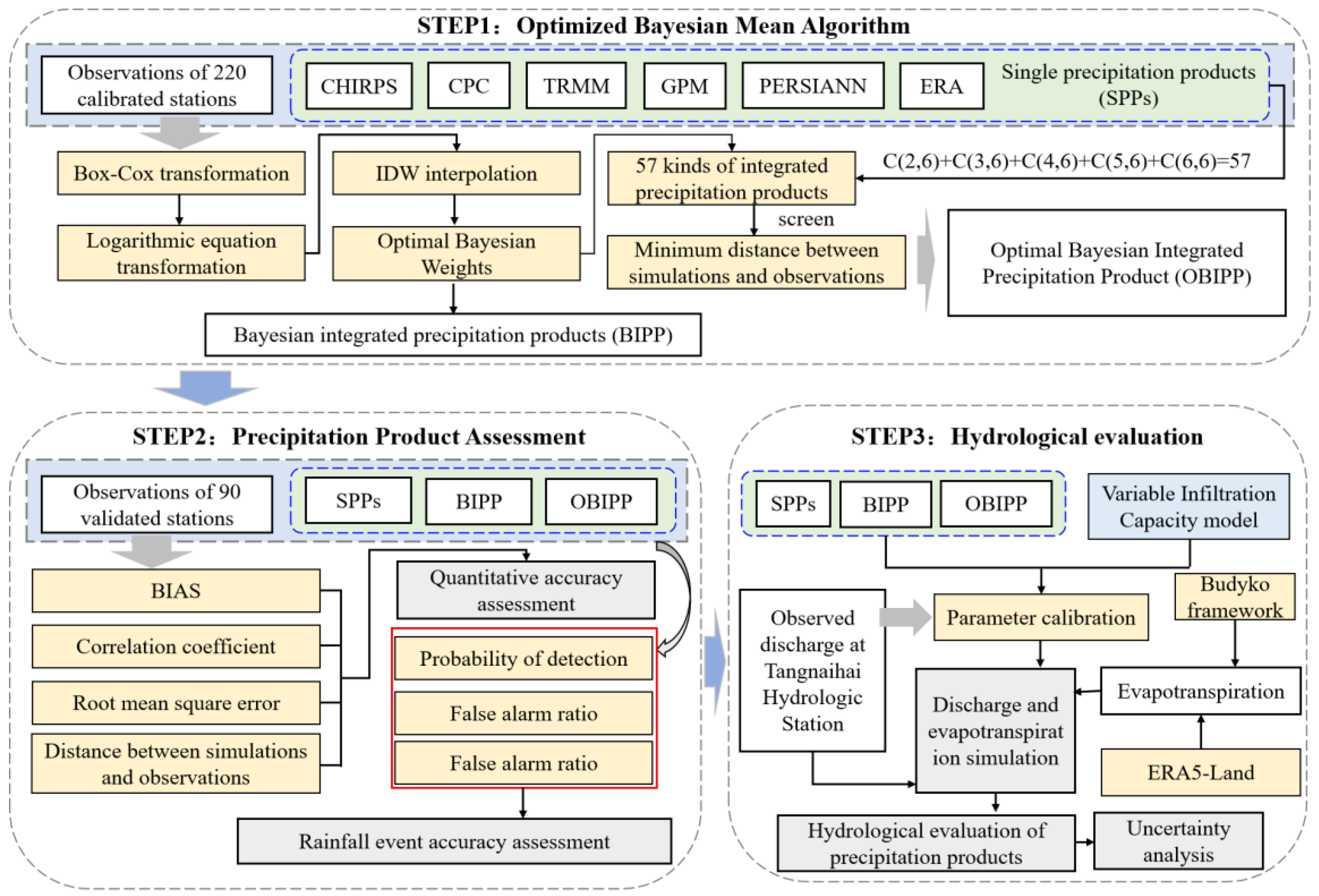

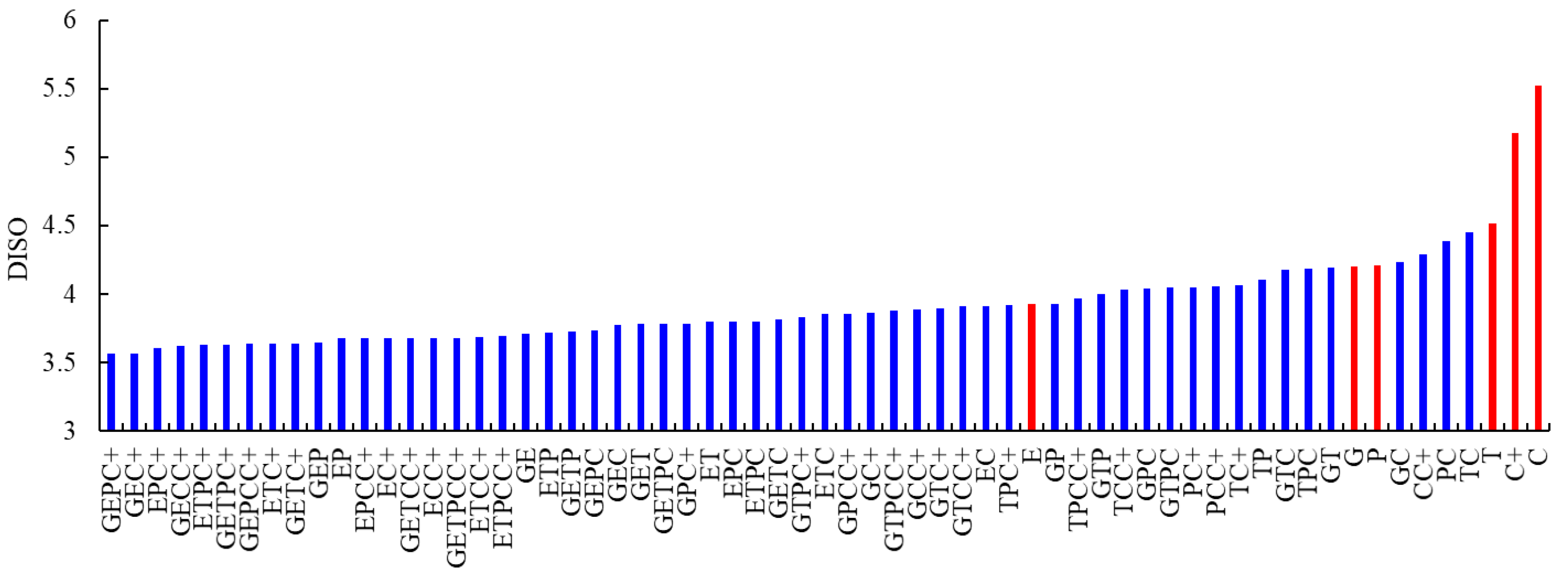

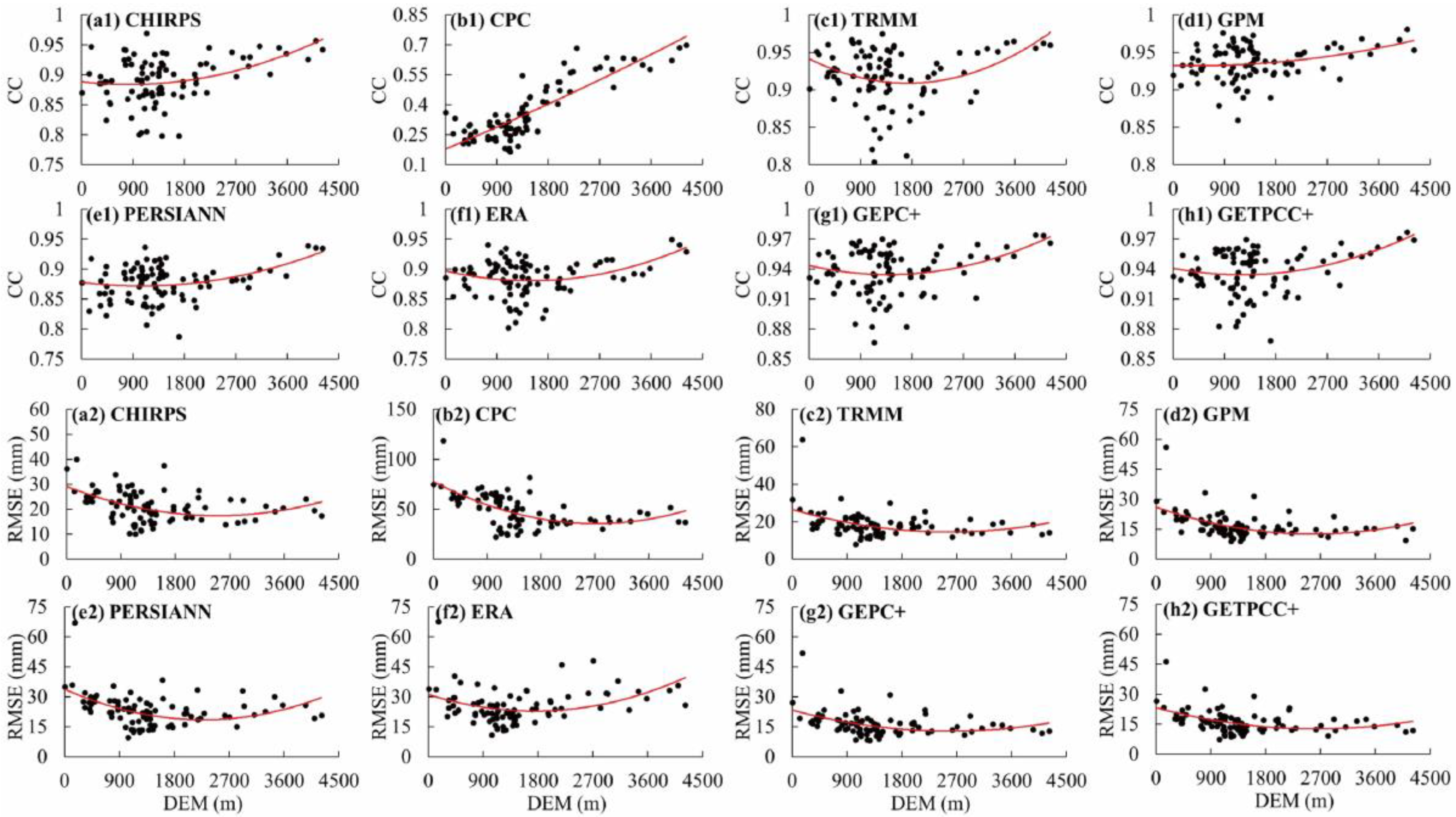
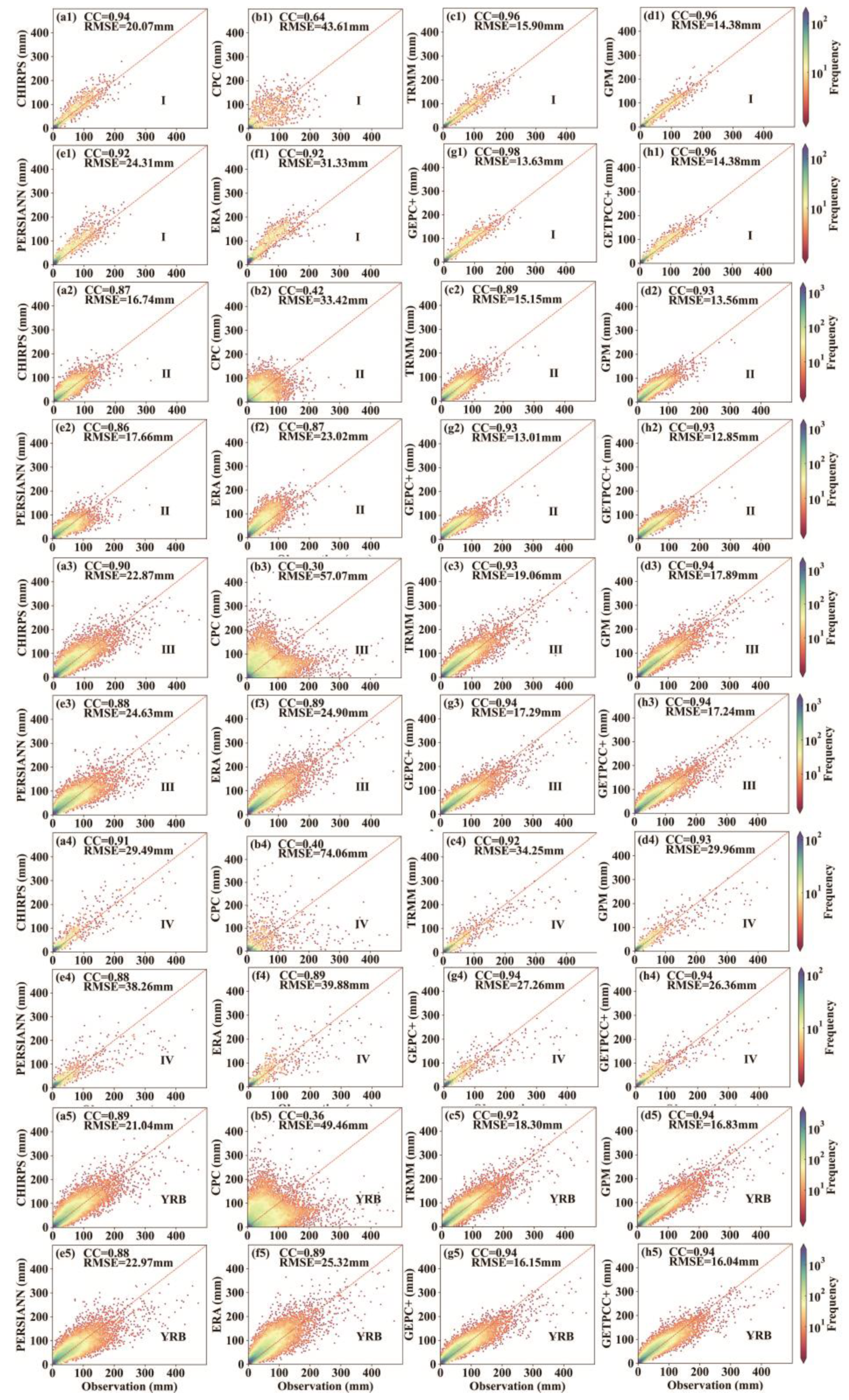
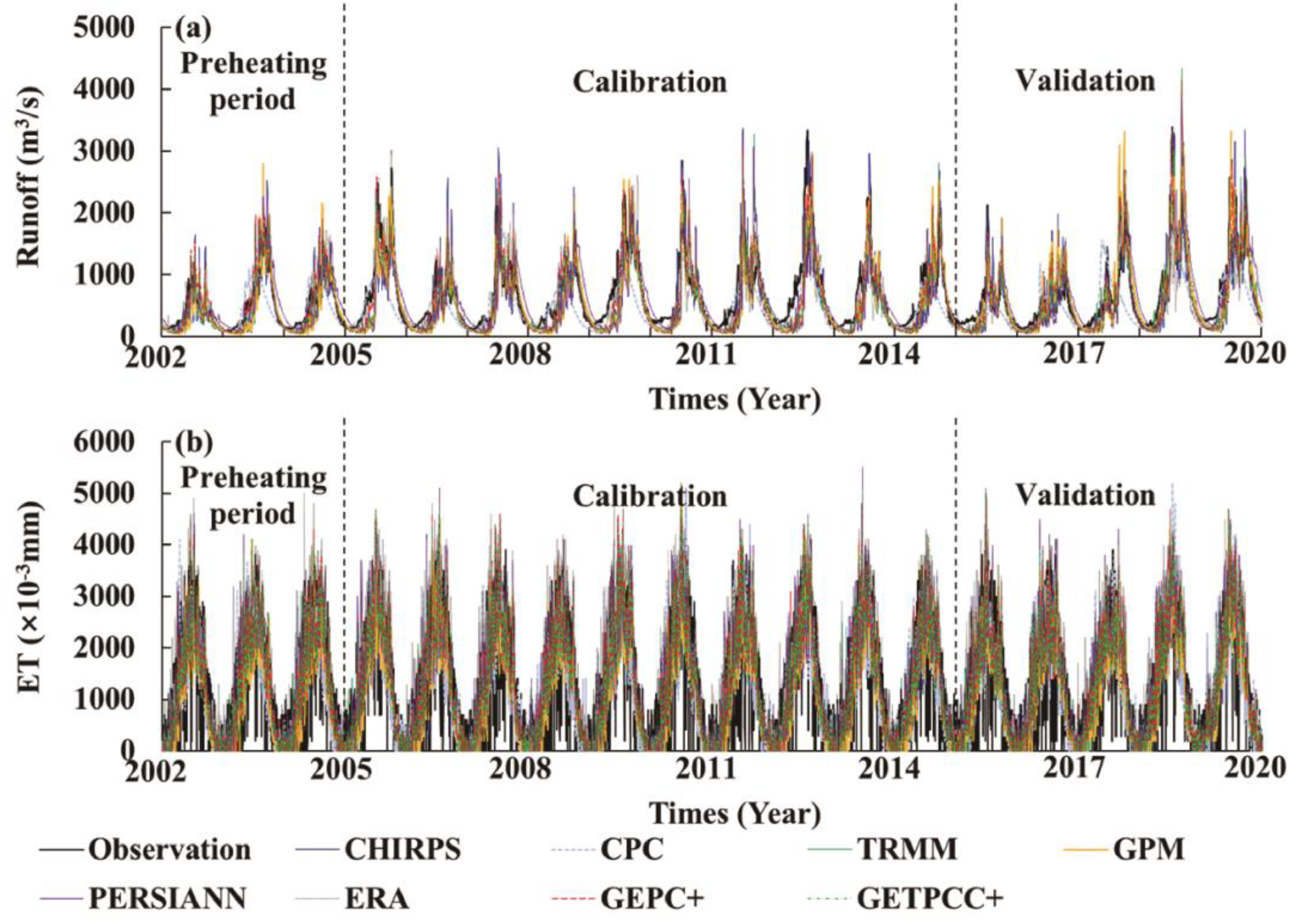

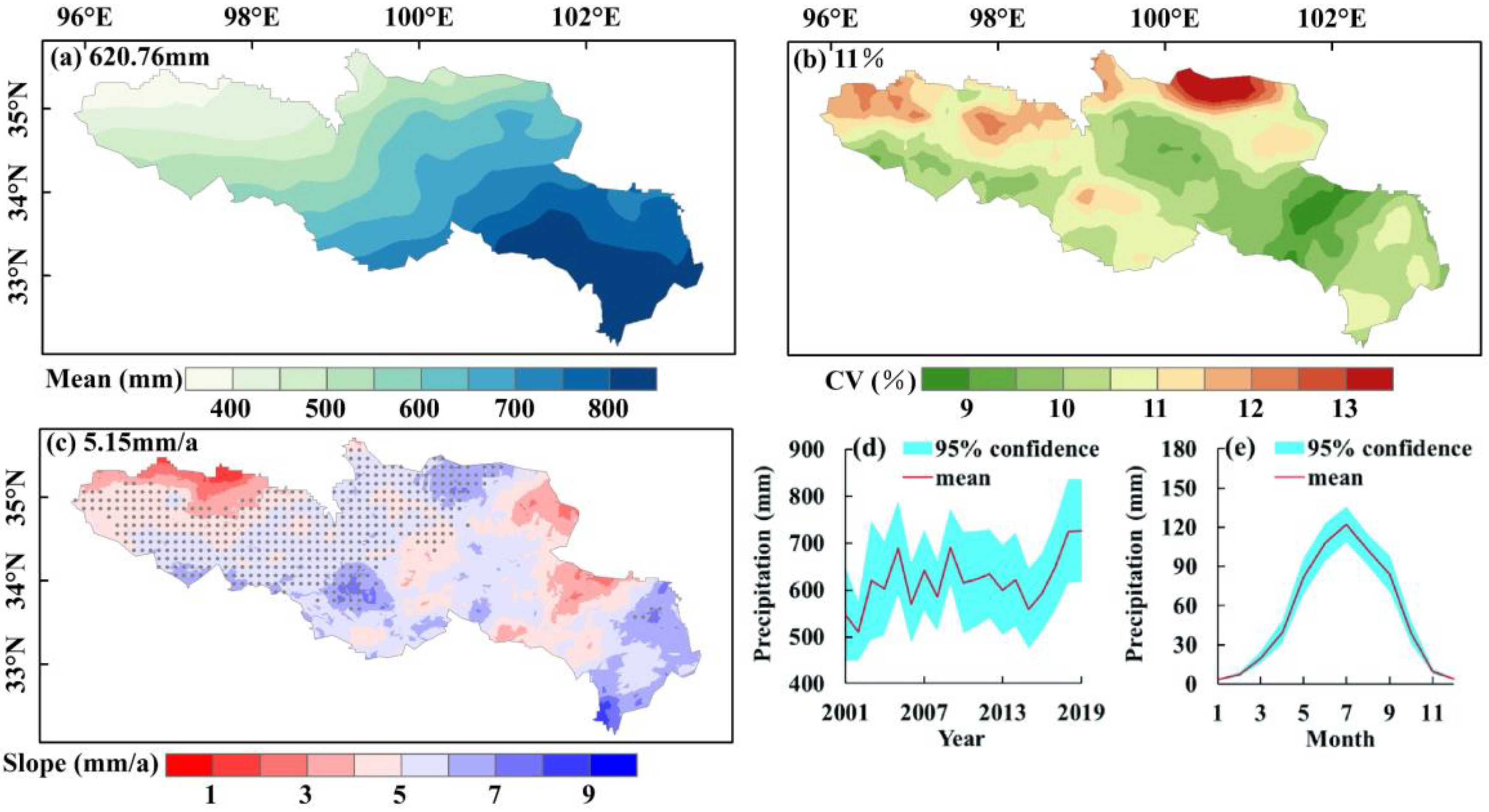
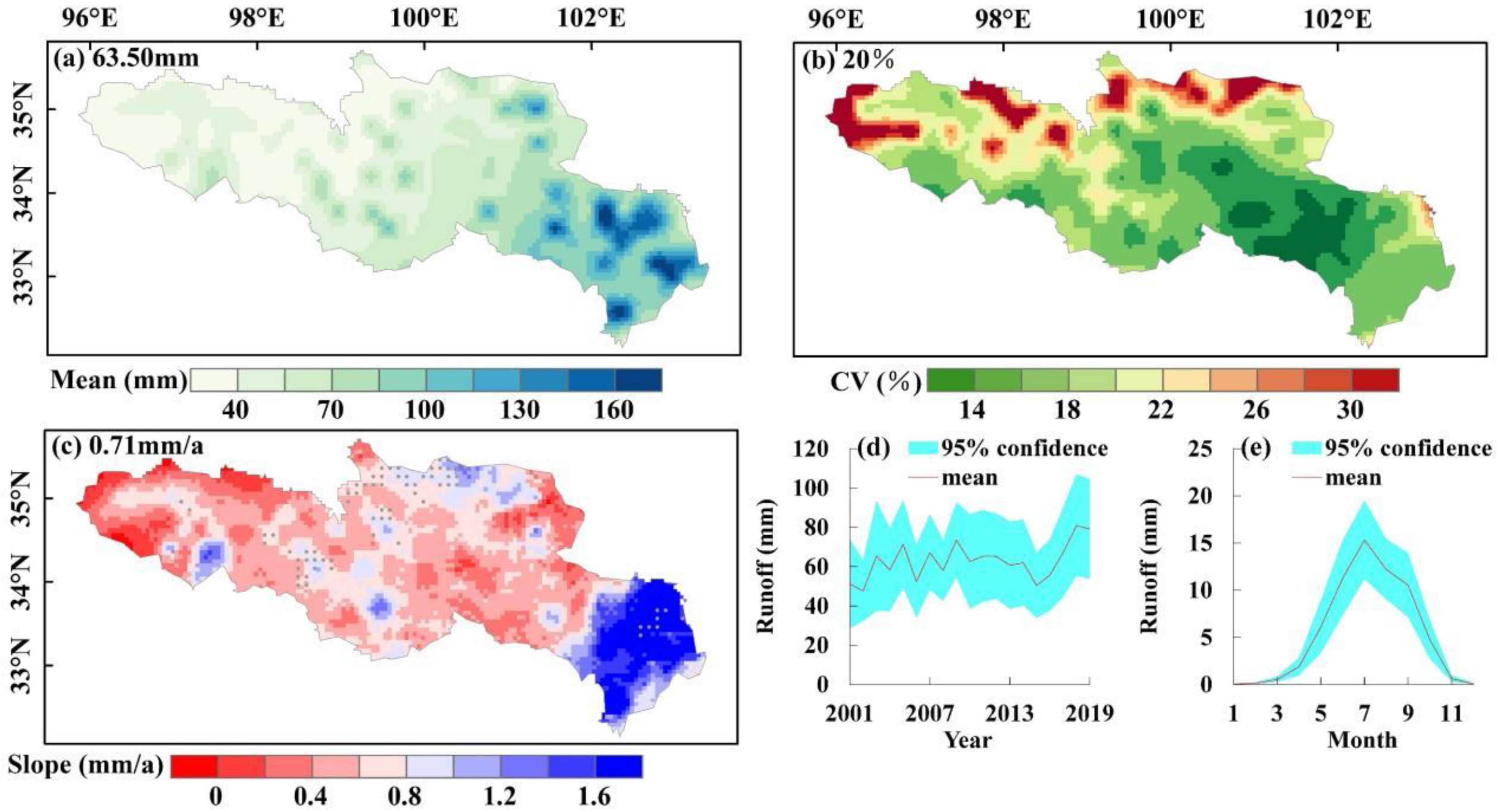
| Precipitation Products | Abbreviation | Temporal Resolution | Spatial Resolution | Time Span | References |
|---|---|---|---|---|---|
| CHIRPS | CHIRPS | Day | 0.05° | 1981 | Funk et al. (2015) [24] |
| CPC | CPC | Day | 0.5° | 1979 | Xie et al. (2007) [25] |
| TRMM-3B42 | TRMM | 3 h | 0.25° | 1998 | Huffman et al. (1997) [26] |
| GPM-IMERG | GPM | 0.5 h | 0.1° | 2000 | Huffman et al. (2014) [27] |
| PERSIANN-CDR | PERSIANN | Day | 0.25° | 1983 | Sorooshian et al. (2000) [28] |
| ERA5-LAND | ERA | 1 h | 0.1° | 1950 | Hersbach et al. (2020) [29] |
| Statistical Indicators | Products | YRB | Ⅰ | Ⅱ | Ⅲ | Ⅳ |
|---|---|---|---|---|---|---|
| BIAS/% | CHIRPS | 9.06 | 10.37 | 12.83 | 6.86 | 8.83 |
| CPC | 1.81 | 0.59 | 6.39 | −0.11 | −4.9 | |
| TRMM | 5.44 | 1.56 | 7.56 | 5.7 | −8.51 | |
| GPM | 7.38 | −2.81 | 12.69 | 6.22 | −3.24 | |
| PERSIANN | 5.82 | 21.47 | 6.72 | 4.5 | −3.14 | |
| ERA | 25.25 | 39.19 | 42.04 | 15.99 | 6.47 | |
| GEPC+ | 7.46 | 10.31 | 13.83 | 3.76 | −3.89 | |
| GETPCC+ | 6.96 | 9.9 | 13.03 | 4.08 | −3.4 | |
| CC | CHIRPS | 0.27 | 0.28 | 0.22 | 0.29 | 0.28 |
| CPC | 0.05 | 0.14 | 0.05 | 0.03 | 0.07 | |
| TRMM | 0.33 | 0.33 | 0.25 | 0.37 | 0.3 | |
| GPM | 0.42 | 0.38 | 0.37 | 0.46 | 0.37 | |
| PERSIANN | 0.29 | 0.32 | 0.24 | 0.32 | 0.31 | |
| ERA | 0.49 | 0.49 | 0.46 | 0.52 | 0.46 | |
| GEPC+ | 0.50 | 0.50 | 0.47 | 0.52 | 0.45 | |
| GETPCC+ | 0.46 | 0.45 | 0.41 | 0.5 | 0.42 | |
| RMSE/(mm·d−1) | CHIRPS | 6.7 | 6.14 | 5.15 | 7.4 | 9.54 |
| CPC | 6.12 | 4.95 | 4.39 | 6.99 | 8.92 | |
| TRMM | 5.38 | 5.1 | 4.18 | 5.86 | 8.03 | |
| GPM | 4.99 | 5.01 | 3.79 | 5.46 | 7.59 | |
| PERSIANN | 5.05 | 5.23 | 3.78 | 5.55 | 7.45 | |
| ERA | 4.67 | 4.07 | 3.6 | 5.14 | 7.09 | |
| GEPC+ | 4.05 | 3.55 | 2.99 | 4.5 | 6.5 | |
| GETPCC+ | 4.39 | 3.9 | 3.31 | 4.84 | 6.85 | |
| DISO | CHIRPS | 5.43 | 3.69 | 5.98 | 5.3 | 5.32 |
| CPC | 5.03 | 3.02 | 5.35 | 5.05 | 4.96 | |
| TRMM | 4.42 | 3.05 | 5 | 4.22 | 4.53 | |
| GPM | 4.06 | 2.99 | 4.49 | 3.91 | 4.27 | |
| PERSIANN | 4.11 | 3.14 | 4.49 | 3.99 | 4.18 | |
| ERA | 3.85 | 2.48 | 4.34 | 3.7 | 3.97 | |
| GEPC+ | 3.26 | 2.06 | 3.61 | 3.17 | 3.49 | |
| GETPCC+ | 3.58 | 2.35 | 3.94 | 3.47 | 3.79 |
| Station | Products | Preheating Period (2002–2005) | Calibration (2006–2015) | Validation (2016–2019) | ||||||
|---|---|---|---|---|---|---|---|---|---|---|
| NSE | CC | BIAS (%) | NSE | CC | BIAS (%) | NSE | CC | BIAS (%) | ||
| TNH (Daily runoff) | CHIRPS | 0.62 | 0.83 | −15.86 | 0.60 | 0.83 | −14.38 | 0.64 | 0.84 | −13.77 |
| CPC | 0.39 | 0.69 | −26.31 | 0.44 | 0.78 | −32.46 | 0.40 | 0.71 | −27.48 | |
| TRMM | 0.71 | 0.87 | −18.57 | 0.57 | 0.81 | −21.94 | 0.70 | 0.86 | −5.81 | |
| GPM | 0.69 | 0.87 | −15.17 | 0.60 | 0.83 | −19.55 | 0.69 | 0.88 | −2.87 | |
| PERSIANN | 0.64 | 0.82 | 0.73 | 0.38 | 0.69 | −14.24 | 0.63 | 0.83 | 0.04 | |
| ERA5 | 0.80 | 0.94 | 11.84 | 0.68 | 0.85 | −13.95 | 0.61 | 0.84 | −25.20 | |
| GEPC+ | 0.76 | 0.90 | 2.40 | 0.74 | 0.89 | −11.10 | 0.81 | 0.92 | −8.45 | |
| GETPCC+ | 0.76 | 0.89 | −6.53 | 0.69 | 0.87 | −16.43 | 0.74 | 0.88 | −14.05 | |
| TNH (Daily ET) | CHIRPS | 0.59 | 0.78 | −11.55 | 0.54 | 0.76 | −9.28 | 0.53 | 0.76 | −6.13 |
| CPC | 0.48 | 0.73 | −14.84 | 0.42 | 0.70 | −12.22 | 0.42 | 0.70 | −7.78 | |
| TRMM | 0.58 | 0.79 | −16.68 | 0.58 | 0.78 | −12.79 | 0.57 | 0.77 | −8.70 | |
| GPM | 0.58 | 0.81 | −23.08 | 0.57 | 0.79 | −19.30 | 0.61 | 0.80 | −12.56 | |
| PERSIANN | 0.57 | 0.78 | 1.56 | 0.53 | 0.76 | 3.43 | 0.52 | 0.77 | 11.37 | |
| ERA5 | 0.42 | 0.82 | 34.43 | 0.37 | 0.79 | 33.64 | 0.35 | 0.79 | 30.27 | |
| GEPC+ | 0.63 | 0.81 | −4.82 | 0.61 | 0.80 | −3.96 | 0.61 | 0.80 | 1.69 | |
| GETPCC+ | 0.62 | 0.80 | −7.17 | 0.60 | 0.79 | −5.96 | 0.60 | 0.79 | −0.47 | |
Disclaimer/Publisher’s Note: The statements, opinions and data contained in all publications are solely those of the individual author(s) and contributor(s) and not of MDPI and/or the editor(s). MDPI and/or the editor(s) disclaim responsibility for any injury to people or property resulting from any ideas, methods, instructions or products referred to in the content. |
© 2023 by the authors. Licensee MDPI, Basel, Switzerland. This article is an open access article distributed under the terms and conditions of the Creative Commons Attribution (CC BY) license (https://creativecommons.org/licenses/by/4.0/).
Share and Cite
Ma, Z.; Yao, R.; Sun, P.; Zhuang, Z.; Ge, C.; Zou, Y.; Lv, Y. Quantitative Evaluation of Runoff Simulation and Its Driving Forces Based on Hydrological Model and Multisource Precipitation Fusion. Land 2023, 12, 636. https://doi.org/10.3390/land12030636
Ma Z, Yao R, Sun P, Zhuang Z, Ge C, Zou Y, Lv Y. Quantitative Evaluation of Runoff Simulation and Its Driving Forces Based on Hydrological Model and Multisource Precipitation Fusion. Land. 2023; 12(3):636. https://doi.org/10.3390/land12030636
Chicago/Turabian StyleMa, Zice, Rui Yao, Peng Sun, Zhen Zhuang, Chenhao Ge, Yifan Zou, and Yinfeng Lv. 2023. "Quantitative Evaluation of Runoff Simulation and Its Driving Forces Based on Hydrological Model and Multisource Precipitation Fusion" Land 12, no. 3: 636. https://doi.org/10.3390/land12030636





